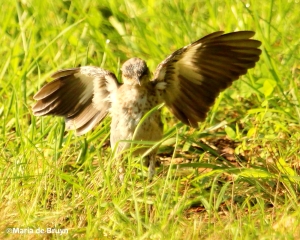 Last year, during a nature walk, I witnessed young Northern mockingbirds (Mimus polyglottos) displaying odd behavior as they strutted around on the ground. They would walk and hop a bit and then suddenly spread their wings wide and wider still, then close them and continue pecking on the ground.
Last year, during a nature walk, I witnessed young Northern mockingbirds (Mimus polyglottos) displaying odd behavior as they strutted around on the ground. They would walk and hop a bit and then suddenly spread their wings wide and wider still, then close them and continue pecking on the ground.
Some research on the Internet revealed that they were engaged in a phenomenon known as wing flashing. There are various theories about why mockingbirds flash their wings -– to startle insects, ward off predators, attract a mate. So far, there is no scientific consensus on why they do this.
Having seen both adult and juvenile birds performing this behavior again this year, however, I’ve become convinced it is part of their hunting technique. Those who promote this idea have suggested that the sudden appearance of the bird’s white wing-bars startles insects, but others argue that insects are not alarmed by the color white.

My own theory is that when the mockingbirds flash their wings, it creates air currents and disturbs the grasses, thereby uncovering and rustling up bugs. This year I clearly saw the birds catching and consuming insects just after a completed wing flash.

Later in the summer, I witnessed a similar kind of wing flashing used as a hunting technique by an entirely different species, the snowy egret (Egretta thula). These elegant white birds have long black legs ending in feet that look like they are covered with yellow rubber gloves. They stalk the shallows of waterways such as marshes and ponds looking for prey. The bird I saw was fishing in tidal pools along the Atlantic Ocean shore.

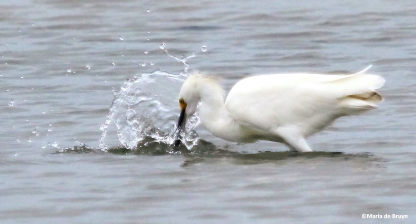
It is thought that the egrets use their large feet to stir up the sand underwater so that they can more easily see potential food as they forage. Part of the time, they will simply stand like statues, waiting for a fish to swim nearby so that they can suddenly plunge their long beaks into the water to get their meal.
 This worked at least part of the time for this particular bird, as s/he got a few fish down. It required a lot of patience, however.
This worked at least part of the time for this particular bird, as s/he got a few fish down. It required a lot of patience, however.
At a certain point, the bird decided on a more active approach. S/he flew to another tidal pool and then began running to and fro in the water, flapping his/her wings open and closed.
Occasionally, this was complemented by a leap into the air and plunge into the water – obviously behavior calculated to startle and scare up the fish lurking below the water’s surface.
It was fascinating for me to see two such different bird species using their wings in a similar fashion as a hunting method. One of the things I love about wildlife watching -– you can always see and learn something new!




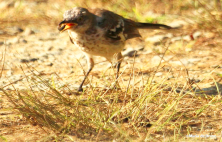
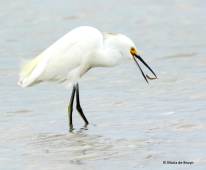

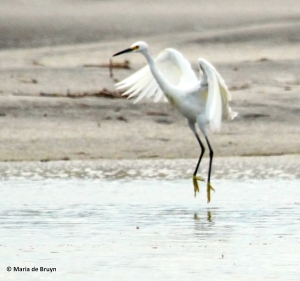


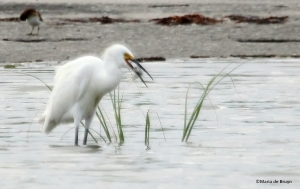
Pingback: A tiny bundle of yellow-feathered joy | My beautiful world
Pingback: All Rise | Wild Life
Interesting theory and observation. Could it also be possible that the Mockingbird’s behavior of wing flashing is a instinctual warning to an extinct predator? These birds have been around for a long long time. This would be very difficult to prove, however.
LikeLike
Since writing the blog, I’ve observed mockingbirds engaged in wing flashing more often; it really seems to me that they are doing it to scare up insects since most of the time after they do it, I’ve seen them eating something. The scientists are still debating the purpose of the behavior, however. Thanks for responding to the blog!
LikeLike
Certainly plausible. I have several returning pairs of Mockingbirds annually. I find them to be extraordinarily interesting creatures. They recognize me and pay no attention. With strangers, cats or squirrels, WW3 begins. I witness these beauties flash their wings while on the ground or perched atop a wall fence. Since there aren’t insects to be had atop the fence, I suppose the wing flashing is reflexive. These ancient birds evolved characteristic behaviors, beak adaptations, coloring and size long before humans emerged. Why did they evolve with large white patches on their wings? It seems to serve no purpose. It is possible that the Mockingbird developed these anomalies against a predator that has gone extinct.
LikeLike
That’s an interesting idea, John! (Maybe the amount of white on the wings makes them more or less attractive to mates; another idea.) Several birders of my acquaintance dislike the mockingbirds, saying they chase everyone else away from feeders. The mockingbirds at my house don’t do that; they seem content to share the feeders with the other birds.
LikeLike
Our Mockingbirds are frantic right now. They have fledglings and work together guarding and distracting prey from their nest. They are noisy through the night and I can hear their baby’s piercing whine, which unfortunately attracts the neighborhood cats and squirrels. These pairs return annually because we always have clean water available to them.
LikeLike
How cool that you have birds returning year after year. I’m fairly certain I have catbirds, ruby-throated hummingbirds and a ruby-crowned kinglet returning here each year. Enjoy the birds!
LikeLike
I feed a pair of mockingbirds (known as ‘The Mobys since I can’t tell them apart) and the polite one flashes wings now and then to me. Both come when I call and almost brazenly unafraid. They have been known to sit on a pot, close to the kitchen window, and look in. So, I’m not sure about the predator or hunter/bug startling theories, but these birds are really enjoyable to watch!
LikeLike
Sorry, forgot to say that I feed them grapes.
LikeLike
Interesting that they eat grapes. The mockingbird in my yard likes to eat some suet now and again!
LikeLike
Hi, Janelle! I’m sure that the mockingbirds will flash their wings for other reasons, too. How cool that they come when you call them – it’s so nice when a wild being chooses to befriend you. Just now, I took a break and a little walk out into my yard and had to stop and listen as one of my resident mockingbirds was giving a concert with the many calls he makes. He sang so beautifully – trills and warbles and raspy calls; it made me wish I could recognize bird calls so I could count how many species he was imitating. He is a talented singer. 🙂
LikeLike
Just moments ago I observed 2 adult mockingbirds defending a fledgling bird they had placed within a bougainvillea bush next to my
window. A big crow was sitting on top of the bush while attacking mockingbirds dived at it. The crow next jumped down on the ground apparently looking for the baby. The crow finally flew off. Immediately after this the two adult birds lit atop the bush and both started flashing their wings while looking into the bush below their feet. They were not hunting for bugs this time. It seemed to me they were Communicating or attempting to do so.
Just an observation.
LikeLike
Oh, that’s very interesting! It wouldn’t be surprising to me if they used the wing flashing as an alarm signal or warning signal or something else. So nice to see that the parents joined together in defending the baby – it’s a perilous time for the young ones. I heard shrill cries in my back yard and looked out to see a blue jay fly off with what appeared to be a small brownish bird. Not what I would have expected as they spend so much time at my feeders! Thanks for sharing that observation!
LikeLike
Pingback: The Northern mockingbird boundary dance | My beautiful world
Hello, thanks for this post. While walking my dogs this morning, I saw a mockingbird flashing its wings, and it flushed out a winged insect. A low level aerial chase ensued, and then the mockingbird flew off with a sizeable bug in its beak. I had never seen this technique before, so searched online for info after I returned home, and came across your blog. Nice photos, and nice explanation!
LikeLike
Thanks for your comment, Emil. The past week, I have again seen the mockingbirds flashing their wings as they hop around fields looking for food. I know a couple scientists do not believe this is a hunting technique but ascribe it to mating or territorial displays. Based on my observations over the years, I believe they flash their wings for different purposes. I’ve seen them do it when defending territory and also when foraging. And I’ve seen other species of birds (mainly sparrows) follow them when they do it because they also get easier access to bugs as well. I appreciate you sharing your observation!
LikeLike
I have 2 local mockingbirds that do it when they land just feet away from me on my porch to get blueberries from me. I don’t think they’re scaring up insects. They know they are getting blueberries. It almost seems more territorial to me but that jury is still out too. This happens about 4-5 times a day but now thinking about it, Neither has done it recently at all.
I open the door & whistle and they come flying in from across the rd somewhere.
When they 1st started coming and doing that it almost seemed nervous to me…like cautiousness, which it may have been since they aren’t doing it now. :::shrug:::
LikeLiked by 1 person
That’s really interesting! Since I wrote this blog, I’ve watched the mockingbirds over the years in all seasons and I think they flash their wings for different reasons. In some cases, it is indeed to scare up insects – and other species of birds follow in their wake sometimes to gather up bugs, too. Sometimes, they do it when courting and sometimes it could be part of a territorial display. So I think they use wing flashing as a versatile mode of communication and foraging. Thanks for sharing your experience – that is really sweet.
LikeLike
I’ve always believed it to be a hunting strategy and I’ve seen Mockingbirds grab a bug immediately afterwards. It doesn’t happen with every wing flash but I don’t catch a fish with every cast. I’ve believed it was the wing movement that causes bugs/moths to flee, as moths do when you walk across the lawn. With its fierce territoriality and deliberate hunting strategy, can you imagine how terrifying a mockingbird-like 6’ tall dinosaur raptor would have been?
LikeLike
Thanks for your comment. I must admit that I hadn’t thought of the mockingbird in an analogy to a dinosaur but that would be scary! 🙂
LikeLike